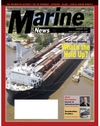
Page 29: of Marine News Magazine (January 2, 2010)
Read this page in Pdf, Flash or Html5 edition of January 2, 2010 Marine News Magazine
Analysis,” was completed for MARAD in August 2006. The objective of this study was to assess the feasibility of short-sea shipping in four poten- tial domestic U.S. traffic corridors: the Gulf to and from the Atlantic
Coast, the Atlantic Coast, the Pacific Coast and the Great Lakes.
The obstacles
Some of the obstacles to short-sea shipping noted in these studies, and by other sources, are slowly being addressed, while others may simply be a fact of life. In September 2009, the U.S. Saint Lawrence Seaway
Development Corporation (SLSDC) and its counter-part, the Canadian
St. Lawrence Seaway Management Corporation (SLSMC), went on a fact-finding mission to Europe to determine why short-sea shipping was so successful in that part of the globe, but far less so in North America.
U.S. and Canadian regulatory barriers were discovered to be one of the biggest obstacles, including cabotage and tax laws. The U.S. has the
Jones Act and Canada has a 25% tax on non-Canadian built / flagged ships. These laws, especially the Jones Act, can be touchy subjects, but
Terry Johnson, SLSDC Administrator, said, “I think we can be honest and straight forward and say that they are big barriers to having short-sea shipping take off.” Johnson reported that Canada is in the process of repealing its 25% tax, at least for vessels of a certain size. “On our side, of course,” he said “the Jones Act isn’t going anywhere.”
The America’s Deep Blue Highway study demonstrated that it’s a game of give and take, as Europe already knows. The study noted that “this impressive use of coastal shipping has come with some pain because lib- eralizing Europe’s domestic shipping market has been accompanied by ‘flagging out’ by some operators and a loss of European shipboard jobs to lower wage foreign competitors.” Weitz said the crewing and flagging of a vessel have very little impact on the cost — it’s the price of building vessels in the U.S. that puts short-sea shipping at a significant disadvan- tage to trucking. Trucks on U.S. roadways can be built anywhere in the world.
What may be going somewhere, someday, is the U.S.’s Harbor
Maintenance Tax (HMT). The HMT is a federal tax imposed on each individual shipper, not the vessel operator, based on the value of the goods being shipped through a port. The tax is placed in a trust fund to be used for maintenance dredging of federal navigational channels. The revenue from the tax is not very great, opponents argue, because shippers simply opt to use roadways where the tax does not apply. Furthermore, many argue that the tax is an unfair burden to shallow-draft coastal and inland shipping, which does not require the harbor dredging necessary for the deep-draft trans-oceanic ships. Gregg Ward, Vice President of
Detroit-Windsor Truck Ferry, a short-sea RoRo service on the Great
Lakes since 1990, said “Currently industry is rallying support around
H.R. 3486 – Short Sea Shipping Act of 2009. In September we had 12 members of Congress who supported this bill. Today, we have 34.” Ward said support is continuing to grow and he hopes Congress will move the bill forward in 2010.
Shipping time continues to be a detractor, even though many advocates of short-sea shipping limit the conversation to non-time sensitive freight.
Dr. Rockford Weitz, Senior Fellow at the
Institute for Global Maritime Studies.
Photo courtesy Rockford Weitz
Collister “Terry” Johnson, Jr., St. Lawrence
Seaway Development Corporation (SLSDC)
Administrator. www.marinelink.com MN 29
Photo courtesy SLSDC

 28
28

 30
30
